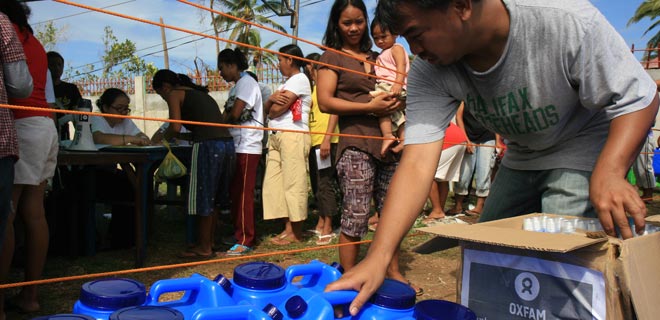One month on, international response has been massive but serious gaps remain. Despite widespread destruction and massive logistical obstacles in the wake of the Philippines typhoon, fast action backed by generous international support and the solidarity of local people has helped millions of people survive and prevented any major outbreak of disease, Oxfam said today.

One month on, international response has been massive but serious gaps remain
Despite widespread destruction and massive logistical obstacles in the wake of the Philippines typhoon, fast action backed by generous international support and the solidarity of local people has helped millions of people survive and prevented any major outbreak of disease, Oxfam said today.
One month on from the worst typhoon to make landfall ever recorded, the international agency says that the Philippines authorities have stepped up to actively lead and coordinate a huge complex aid effort. That effort – combined with widespread evacuations ahead of the storm – has helped to save lives and prevent a public health emergency despite the destruction of hospitals, clinics, and water supplies.
Donors and members of the public from around the world gave generous support: nearly $400m of aid was pledged within the first few weeks and military assets were provided that helped to overcome the extreme logistical challenges. These obstacles include damaged airports, seaports, roads and bridges, vast jungles of debris, as well as a loss of communications that plunged much of the disaster zone into an information black hole.
Barry Coates, Oxfam New Zealand Executive Director said: “We can be proud of New Zealand’s response to Typhoon Haiyan – there has been a humbling effort from the New Zealand public who have fundraised up and down the country to contribute to Oxfam’s appeal, a generous response from the New Zealand government and a very useful contribution from the New Zealand defence forces. Now the hard stuff starts. Oxfam has been in Philippines for 60 years and we will be there for the long haul to help people recover their families, communities and livelihoods. We hope that the public will join us in continuing our contribution to help people not only recover, but build back better.”
After the initial chaos caused by Haiyan’s impact, the United Nations, local, national and international organisations have also worked well together with the government, to improve coordination and expand the aid effort. Oxfam has now reached a quarter of a million people with aid, including by helping to restore Tacloban’s water supply.
Oxfam’s Country Director in the Philippines Justin Morgan said: “It’s been immensely challenging to get aid through, but the response, both from the people of the Philippines and the international community, has been amazing.
“Our main concern now is supporting rural communities who have not received anything like adequate assistance yet and making sure people are able to quickly rebuild their homes, infrastructure and livelihoods, in a way that will make them more resilient to future shocks.”
A report published today by Oxfam, warns that major gaps remain, with millions of people especially in rural and hard to reach areas, having received little official aid. Many have relied on local charities, churches and their fellow citizens at home and abroad. Oxfam says the relief effort must expand faster to provide enough assistance to everyone who needs it.
In addition, substantial longer term support will be needed to prevent affected areas, many of which were already amongst the poorest parts of the Philippines, sliding further into poverty, and exposing communities to greater risks from the next typhoon in a disaster prone country.
Massive needs remain. Nearly 3 million people are relying on some form of food assistance and 4 million people are homeless and in need of shelter. An Oxfam assessment in northwest Leyte found some communities had nothing to eat except the food aid they received and less than 10 per cent had proper emergency shelter. There are also risks to the safety of vulnerable groups such as woman and children. The need to accelerate and expand the aid effort is indisputable.
Local organisations are worried that climate change will likely cause typhoons like Haiyan to be more common in the future.
Voltaire Alferez, National Coordinator of one of Oxfam’s partners in the Philippines, Aksyon Klima Pilipinas, said: “Typhoon Haiyan is the shape of things to come – with climate change set to increase the severity of typhoons in the region and projected sea level rises to compound the effects of deadly storm surge. The Philippines will need sustained support and programmes to prepare for more storms like this. Ultimately it also needs action on reducing the threat of climate change.”
The Philippines is hit by approximately 20 typhoons a year and has been relatively successful at preparing for and reducing the risk of disasters. It evacuated 800,000 people in the wake of the storm which undoubtedly saved many lives. However it needs to redouble its efforts to make sure those authorities and organisations at the frontline of any disaster response must be better equipped to deal with future shocks. The underlying poverty and inequality that made people vulnerable lie at the heart of why the communities in the Philippines were so severely hit. Addressing these issues should be a priority as the country goes forward.
Record breaking storms such as Haiyan show that the most powerful storms will inevitably cause destruction. The need for international agreements to cut the carbon emissions that fuel global warming is far beyond urgent.



